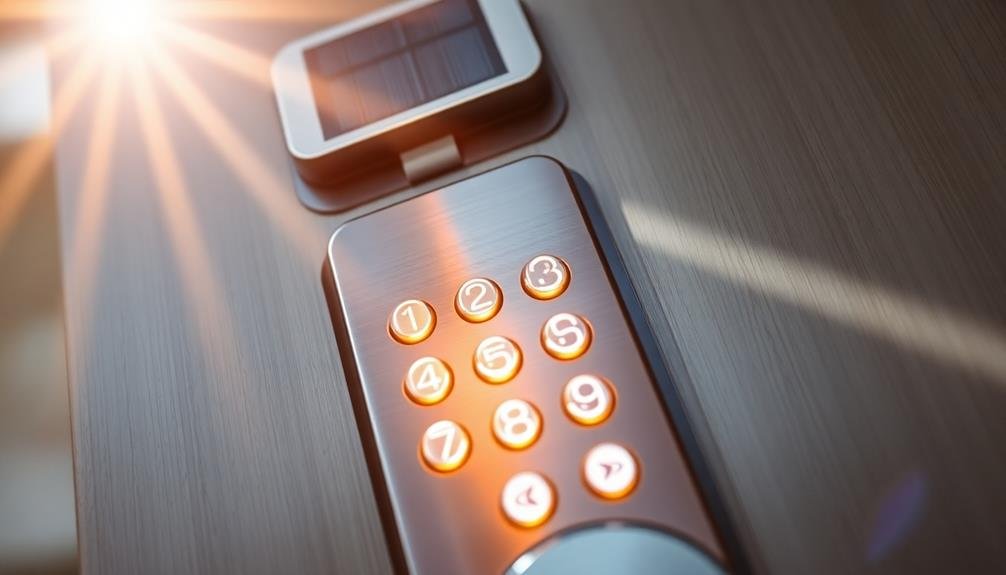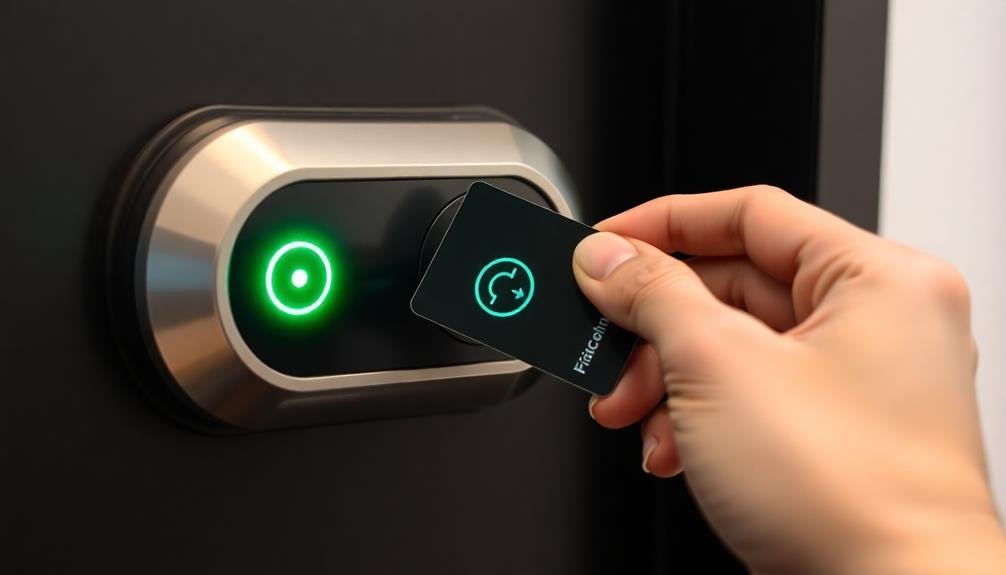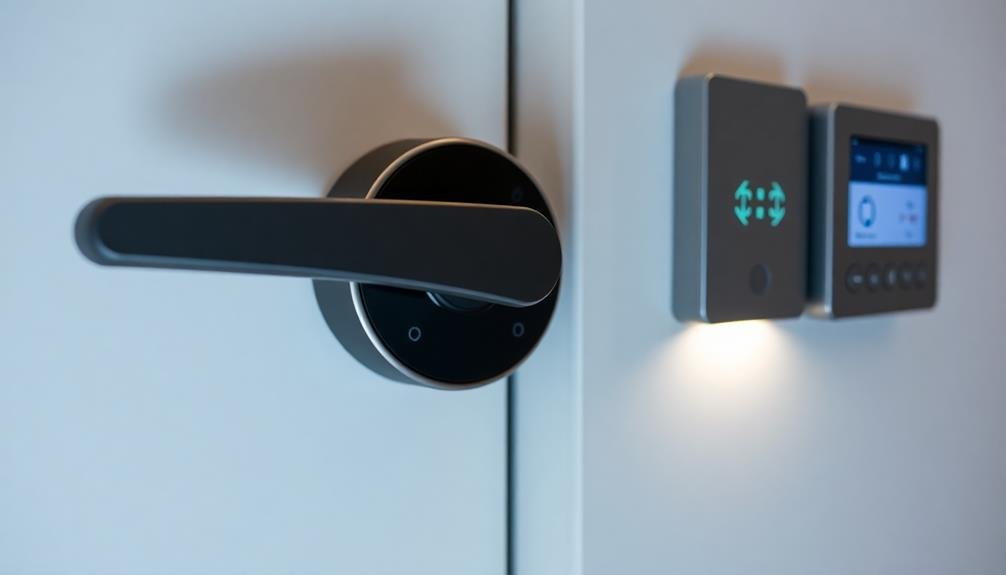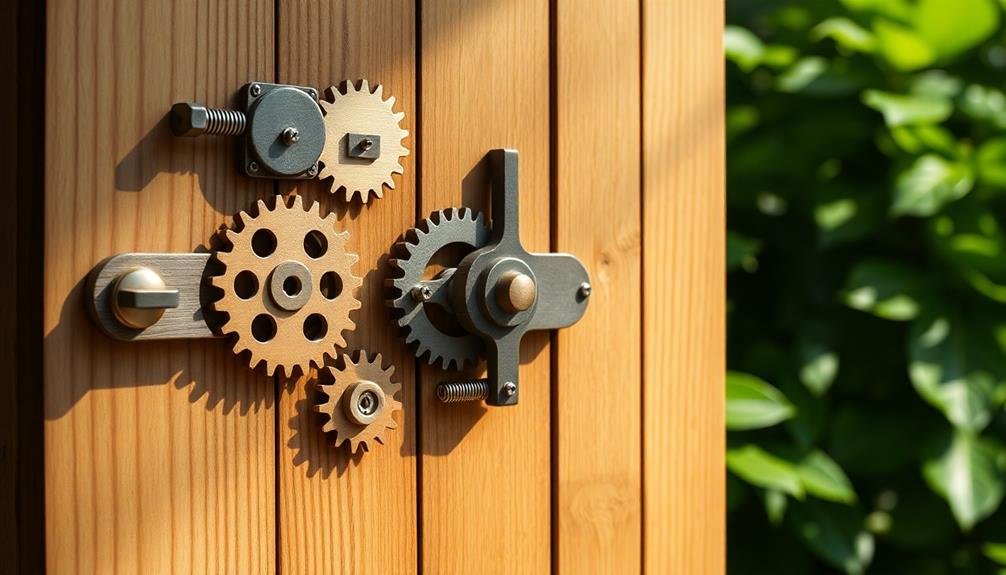You can build five energy-saving home locks yourself, enhancing security while reducing power consumption. Try a solar-powered keypad lock that harnesses sunlight for operation. Consider a Bluetooth-enabled deadbolt system, controllable via your smartphone. An RFID card entry lock offers a key-free, efficient solution. For personalized access, construct a fingerprint recognition door handle that activates only when needed. Finally, explore a voice-activated smart lock for hands-free convenience. These DIY projects combine cutting-edge technology with eco-friendly features, allowing you to customize your home security. Discover how each lock works and start crafting your own sustainable safety solution.
Solar-Powered Keypad Lock

Powered by the sun's energy, a solar-powered keypad lock offers an eco-friendly and convenient way to secure your home. This DIY project combines sustainability with modern security, allowing you to create a reliable locking system without relying on traditional power sources.
To build your solar-powered keypad lock, you'll need a small solar panel, a rechargeable battery, a microcontroller, a numeric keypad, and an electric door strike. Start by connecting the solar panel to the battery through a charge controller to guarantee proper charging.
Next, wire the microcontroller to the keypad and program it to recognize your chosen access code. Install the electric door strike on your door frame and connect it to the microcontroller.
Mount the solar panel in a location that receives ample sunlight, guaranteeing a consistent power supply. Finally, secure the keypad near your door for easy access.
This DIY lock not only reduces your energy consumption but also provides added security features. You can program multiple access codes, set time-restricted entry, and even integrate it with your smart home system for remote access control.
With proper maintenance, your solar-powered keypad lock will provide long-lasting, eco-friendly security for your home.
Bluetooth-Enabled Deadbolt System
Frequently, homeowners are turning to Bluetooth-enabled deadbolt systems for a convenient and secure way to lock their doors.
These systems allow you to control your locks using your smartphone, eliminating the need for physical keys. To create your own Bluetooth-enabled deadbolt, you'll need a smart lock mechanism, a Bluetooth module, and a microcontroller.
Start by removing your existing deadbolt and installing the smart lock mechanism. Connect the Bluetooth module and microcontroller to the lock's control board. Program the microcontroller to interpret Bluetooth signals and activate the lock accordingly.
You'll also need to develop a mobile app to communicate with the lock. Ensure your system includes robust security features, such as encryption and user authentication.
Add a backup power source, like a small battery pack, to prevent lockouts during power outages. Consider incorporating a manual key override for emergencies.
This DIY project offers several benefits: it's energy-efficient, as it only draws power when actively locking or releasing; it provides convenience through smartphone control; and it enhances security by allowing you to monitor access and grant temporary permissions to guests or service providers.
RFID Card Entry Lock

Security-conscious homeowners can create their own RFID card entry lock as an energy-efficient alternative to traditional key systems. This DIY project combines modern technology with energy conservation, offering a secure and convenient way to access your home.
To build your RFID card entry lock, you'll need:
- An RFID reader module
- A microcontroller (like Arduino)
- An electric door strike or magnetic lock
- RFID cards or key fobs
Begin by connecting the RFID reader to your microcontroller and programming it to recognize authorized cards. Install the electric door strike or magnetic lock on your door frame, ensuring it's compatible with your existing door.
Wire the lock to the microcontroller, which will control its operation based on RFID input.
You'll save energy with this system as it doesn't require constant power like some electronic locks. The RFID reader only activates when a card is present, conserving electricity.
Program the microcontroller to enter a low-power sleep mode when idle, further reducing energy consumption.
Customize your setup by adding features like time-restricted access or logging entry attempts. You can even integrate it with your home automation system for enhanced control and monitoring.
With your DIY RFID card entry lock, you'll enjoy improved security and energy efficiency.
Fingerprint Recognition Door Handle
While RFID card entry locks offer enhanced security, fingerprint recognition door handles take personalized access to the next level. You can build your own fingerprint-activated door handle to save energy and increase your home's security. This biometric system allows you to program multiple fingerprints, guaranteeing that only authorized individuals can enter.
To create this DIY lock, you'll need a fingerprint sensor module, a microcontroller like Arduino, a solenoid lock, and a power supply. Start by connecting the fingerprint sensor to the microcontroller and programming it to recognize and store fingerprints.
Then, wire the solenoid lock to the microcontroller, which will trigger the lock mechanism when a valid fingerprint is detected. Install the components inside a custom-made door handle or modify an existing one to accommodate the new hardware.
Confirm that the fingerprint sensor is easily accessible and protected from the elements. This system consumes minimal power when idle and only activates briefly during the authentication process, making it an energy-efficient choice.
You can further optimize power consumption by incorporating a sleep mode for the microcontroller and using a rechargeable battery with a solar panel for sustainable operation.
Voice-Activated Smart Lock

Ever wished you could open your door with just your voice? With a DIY voice-activated smart lock, you can make this a reality while saving energy. This innovative lock system uses minimal power and enhances your home's security.
To create your own voice-activated smart lock, you'll need:
- A smart lock mechanism
- A voice recognition module
- A microcontroller (e.g., Arduino or Raspberry Pi)
- Power source (batteries or low-voltage wiring)
Start by connecting the voice recognition module to your microcontroller. Program it to recognize specific voice commands and trigger the lock mechanism.
Install the smart lock on your door, ensuring it's properly aligned. Connect the microcontroller to the lock, then power up the system.
You can customize voice commands for locking and opening. For added security, use a unique passphrase or combine voice recognition with other authentication methods. Remember to include a manual override for emergencies.
This DIY project not only saves energy but also adds convenience to your daily life. You'll never fumble for keys again, and you can easily grant access to visitors remotely.
With some basic electronics knowledge and careful installation, you'll have a cutting-edge, energy-efficient security solution for your home.
Frequently Asked Questions
How Much Money Can I Save Annually by Installing Energy-Saving Locks?
You'll save $50-$200 annually by installing energy-saving locks, depending on your current locks and energy costs. They'll reduce drafts, improve insulation, and lower heating and cooling expenses. It's a small change with noticeable savings over time.
Are These DIY Locks as Secure as Professionally Installed Security Systems?
DIY locks typically aren't as secure as professional systems. You'll miss out on advanced features, expert installation, and monitoring services. However, if you're handy and follow instructions carefully, you can create a reasonably secure setup for your home.
What Tools and Skills Are Required to Build These Locks Myself?
You'll need basic carpentry tools like saws, drills, and screwdrivers. Skills required include measuring, cutting, and assembling. You should be comfortable working with wood and metal. It's helpful to have some experience with simple DIY projects.
Can These Locks Be Integrated With Existing Home Automation Systems?
You can integrate these locks with many home automation systems. They're often compatible with smart hubs, allowing you to control them remotely. You'll need to verify your chosen lock has wireless connectivity and is compatible with your existing setup.
How Long Does It Typically Take to Build and Install Each Lock?
You'll typically spend 2-4 hours building and installing each lock. It depends on your DIY skills and the lock's complexity. With practice, you'll get faster. Don't rush; take your time to guarantee proper installation and functionality.
In Summary
You've now got five DIY options to secure your home while saving energy. Whether you're tech-savvy or just starting out, there's a project here for you. Remember, the key is to choose a lock that fits your lifestyle and security needs. Don't be afraid to experiment and combine features. With a bit of effort, you'll have a custom, energy-efficient lock that'll make you feel safer and smarter. So pick your favorite and get building!





Leave a Reply